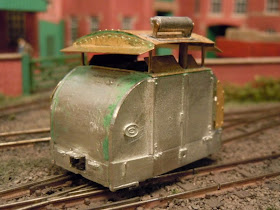Before assembly the chassis retaining nut was epoxied in place, and I cut the square holes in each end for the Microtrains couplings. Then after some fettling of the joins to get the best possible fit I used epoxy glue to join the whitemetal body parts, checking the body was square while it set.
The next job was to fit the chassis. I chose to use the Mk1 version of the Meridian chassis as it allowed the body to sit slightly lower, and left more space either end for the couplings. Also the Mk2 suited the other project better. I'd already soldered the mounting brackets to the chassis which is then retained by a bolt through the previously mentioned nut, but I found a little packing from 20 thou plasticard helpful, with small pieces of plastic to prevent sideways movement at the free end.
The above picture also shows how tricky it was to fit the couplings, I added a piece of 40 thou plastic inside each buffer beam and drilled a hole between that and the whitemetal to take the retaining screw. This leaves a minimal amount of the coupling body protruding and keeps the couplings secure, but one coupling needs to be removed to access the chassis retaining screw.
The next task was the etched roof, having chosen the "protected" version as I find it more interesting than the (easier to build!) fully armoured version. The parts are easy enough to fold up and curve, and I managed to solder the main parts together. The tricky part was soldering the wire supports in place while keeping everything square.
I did cop out of soldering the end overlays for fear of the rest coming unstuck, instead gluing them in pace afterwards. The whole thing was then epoxied onto the body, then the exhaust casting super-glued on top.
As you can see from this photo I've got it sat nice and low to the rails. The green patches are filler, though I'll have to get a coat of primer onto it to see if there are any other gaps.





No comments:
Post a Comment
Due to surprisingly high levels of Spam all comments will now need moderation. If you are advertising, don't bother, otherwise I must apologise if there is a delay in comments being visible, please don't let that put you off!